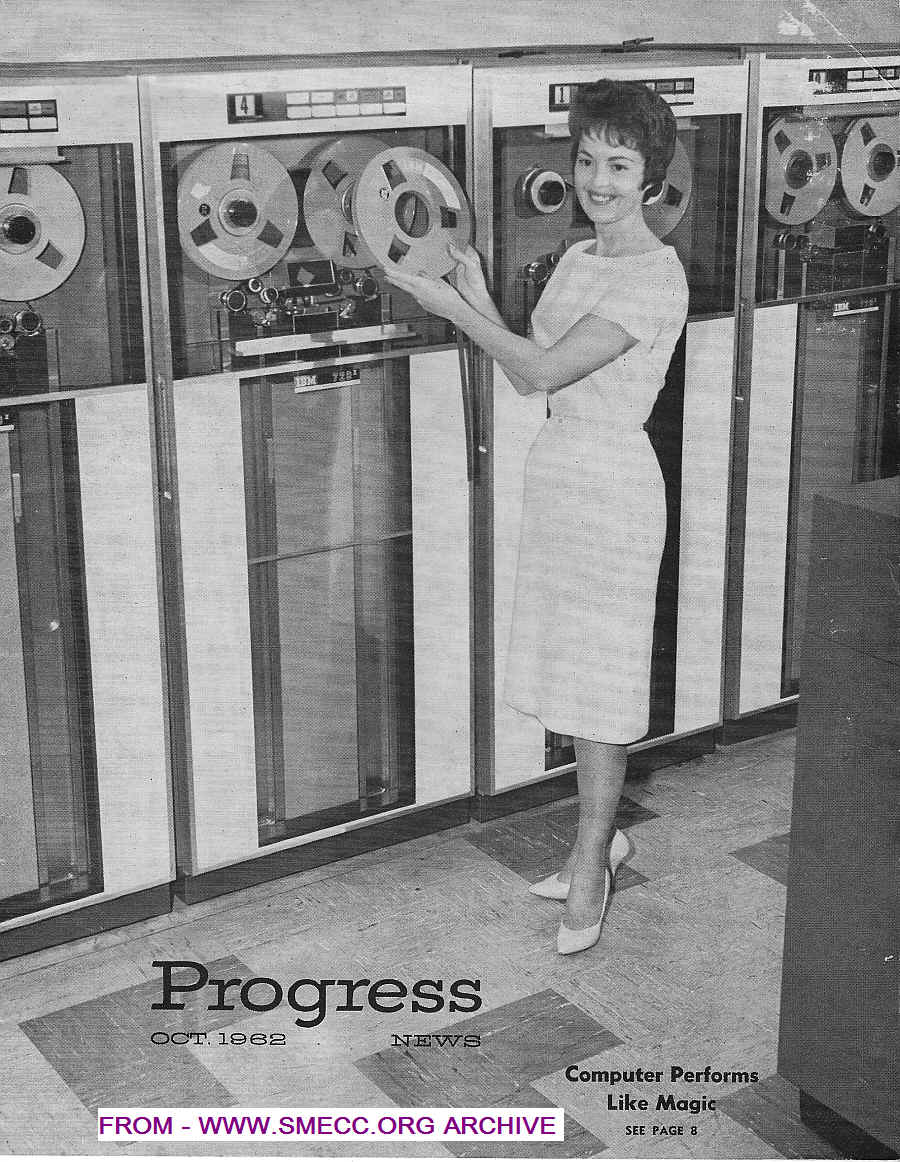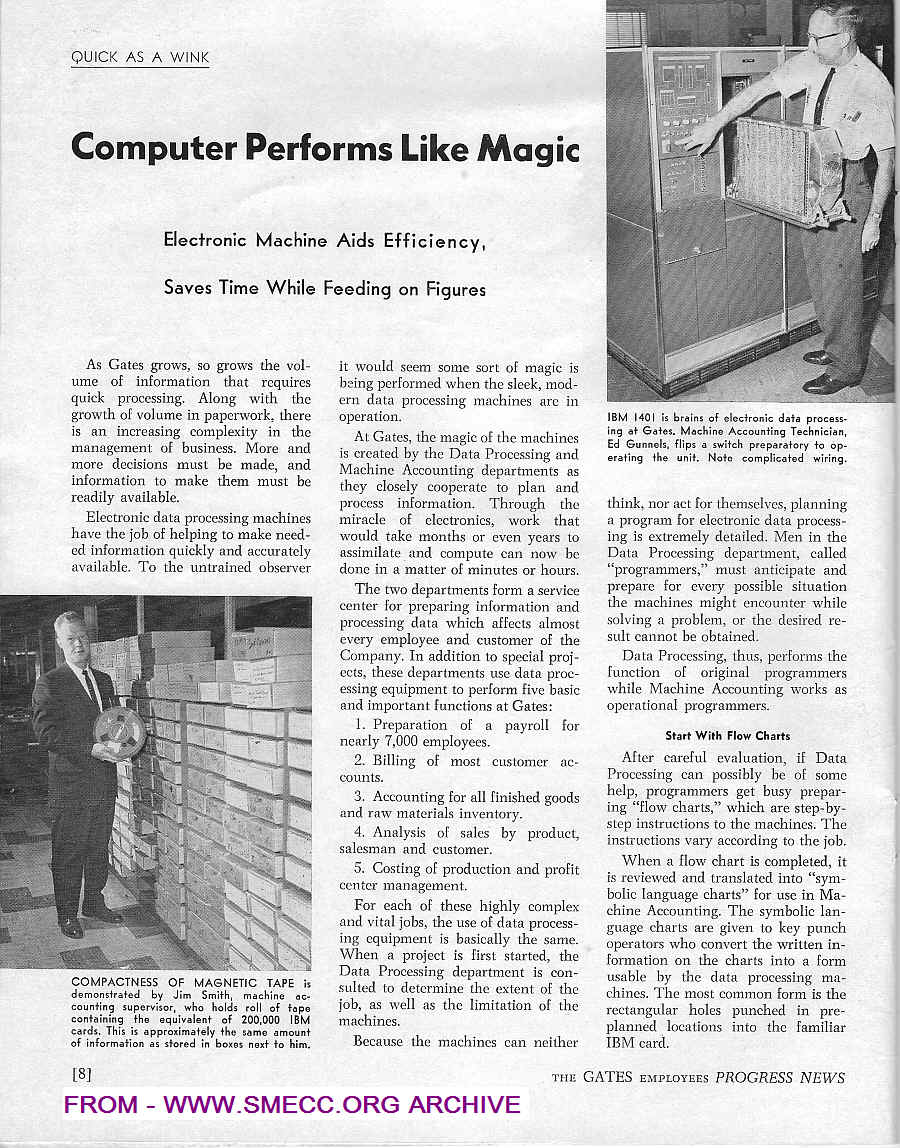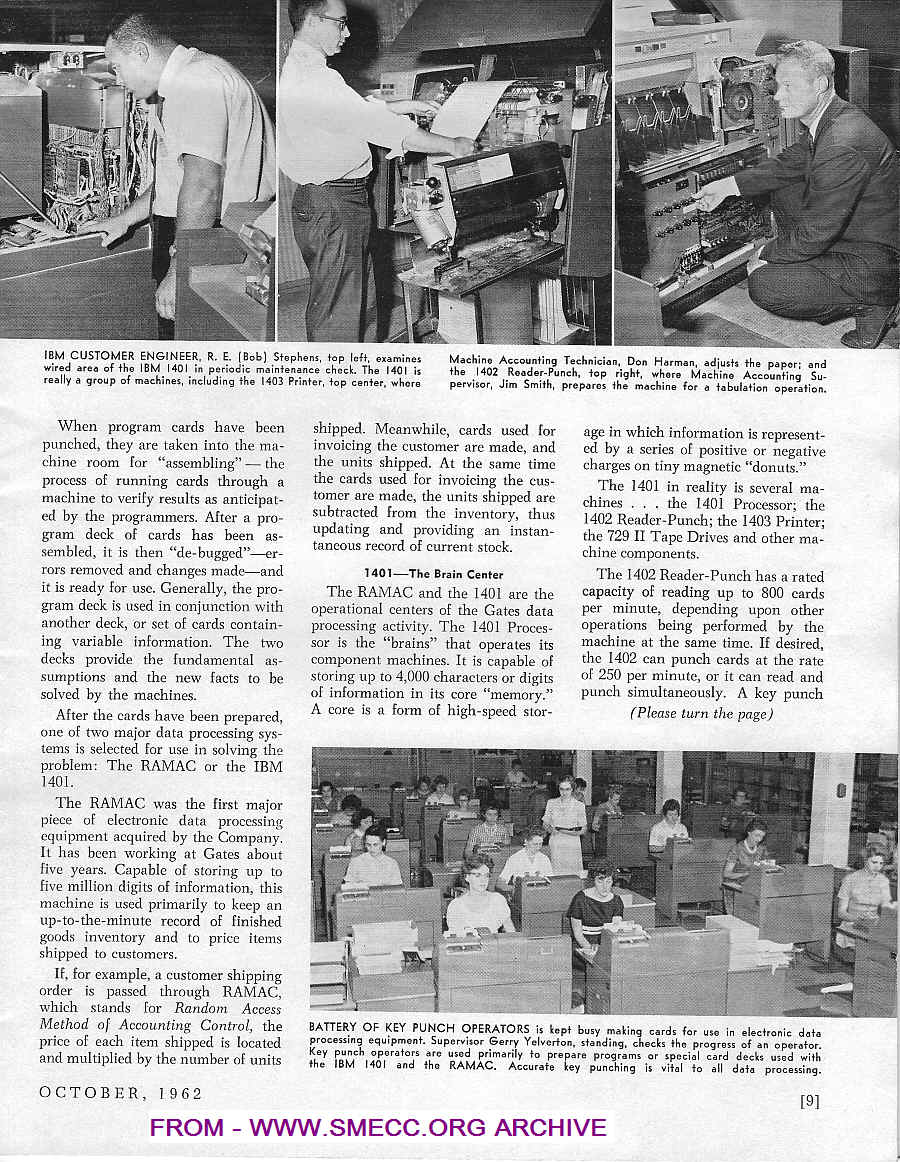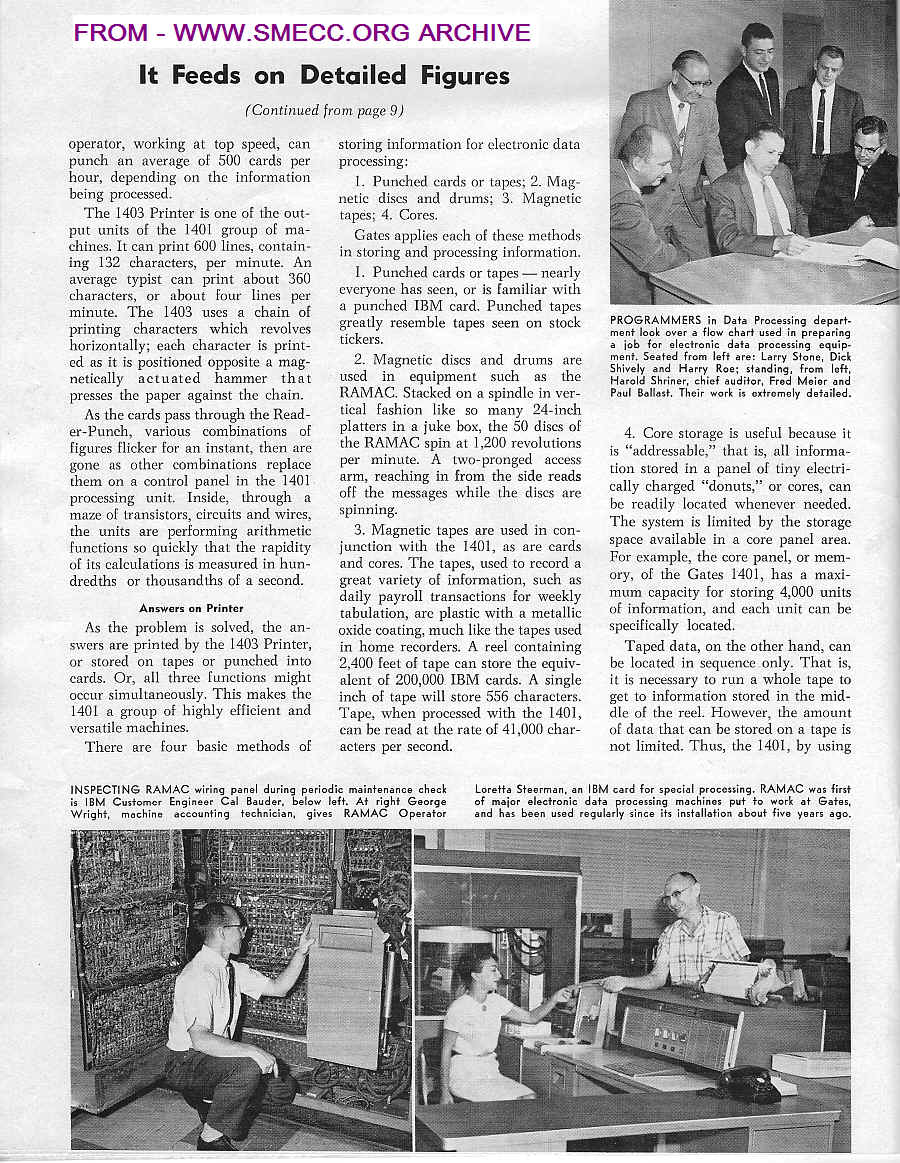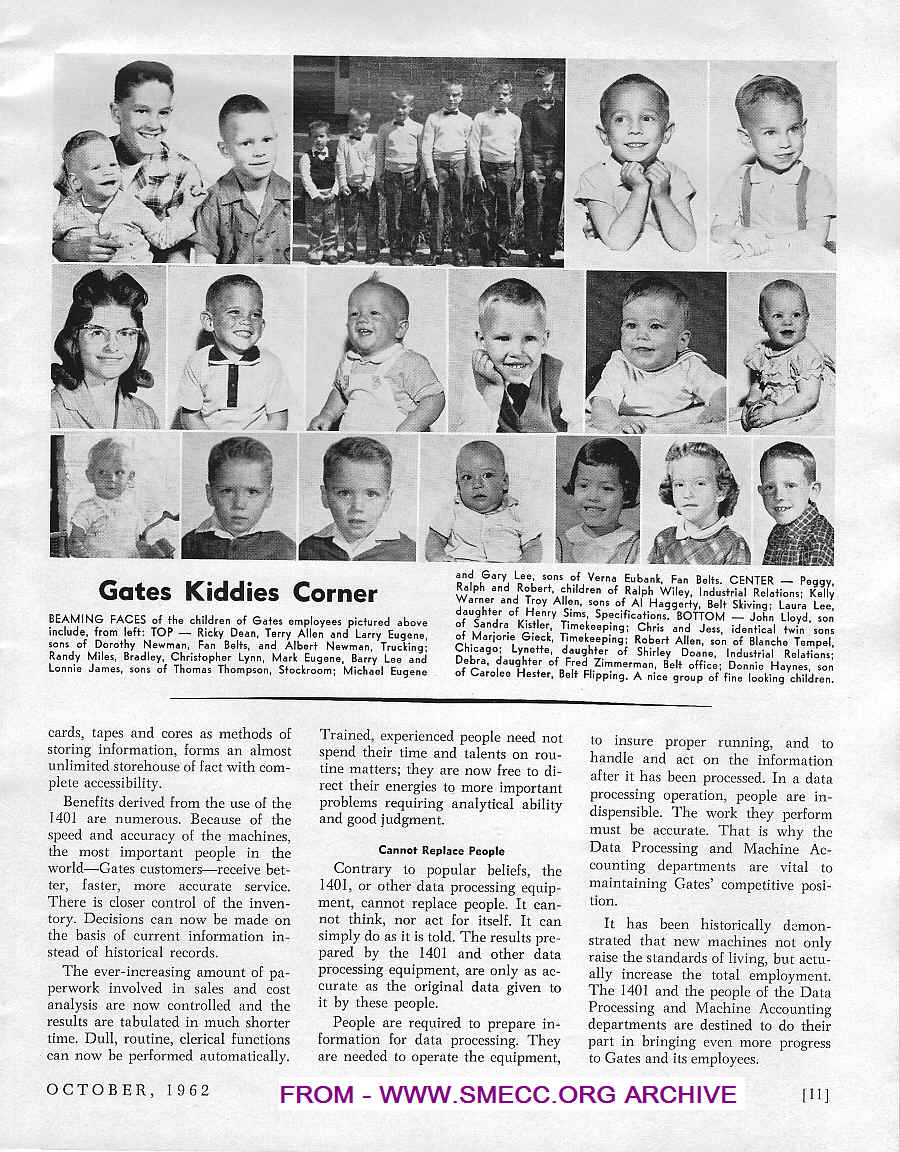|
|
|
| QUICK AS A WINK Computer Performs Like Magic Electronic Machine Aids Efficiency, Saves Time While Feeding on Figures As Gates grows, so grows the vol ume of information that requires quick processing. Along with the growth of volume in paperwork, there is an increasing complexity in the management of business. More and more decisions must be made, and information to make them must be readily available. Electronic data processing machines have the job of helping to make need ed information quickly and accurately available. To the untrained observer COMPACTNESS OF MAGNETIC TAPE is demonstrated by Jim Smith, machine ac counting supervisor, who holds roll of tape containing the equivalent of 200,000 IBM cards. This is approximately the same amount of information as stored in boxes next to him. [8] it would seem some sort of magic is being performed when the sleek, mod ern data processing machines are in operation. At Gates, the magic of the machines is created by the Data Processing and Machine Accounting departments as they closely cooperate to plan and process information. Through the miracle of electronics, work that would take months or even years to assimilate. and compute can now be done in a matter of minutes or hours. The two departments form a service center for preparing information and processing data which affects almost every employee and customer of the Company. In addition to special proj ects, these departments use data proc essing equipment to perform five basic and important functions at Gates: 1. Preparation of a payroll for nearly 7,000 employees. 2. Billing of most customer ac counts. 3. Accounting for all finished goods and raw materials inventory. 4. Analysis of sales by product, salesman and customer. 5. Costing of production and profit center management. For each of these highly complex and vital jobs, the use of data process ing equipment is basically the same. When a project is first started, the Data Processing department is con sulted to determine the extent of the job, as well as the limitation of the machines. Because the machines can neither IBM 1401 is brains of electronic data process ing at Gates. Machine Accounting Technician, Ed Gunnels, flips a switch preparatory to op erating the unit. Note complicated wiring. think, nor act for themselves, planning a program for electronic data process ing is extremely detailed. Men in the Data Processing department, called "programmers," must anticipate and prepare for every possible situation the machines might encounter while solving a problem, or the desired re sult cannot be obtained. Data Processing, thus, performs the function of original programmers while Machine Accounting works as operational programmers. Start With Flow Charts After careful evaluation, if Data Processing can possibly be of some help, programmers get busy prepar ing "flow charts," which are step- by step instructions to the machines. The instructions vary according to the job. When a flow chart is completed, it is reviewed and translated into "sym bolic language charts" for use in Ma chine Accounting. The symbolic lan guage charts are given to key punch operators who convert the written in formation on the charts into a form usable by the data processing ma chines. The most common form is the rectangular holes punched in pre planned locations into the familiar IBM card. THE GATES EMPLOYEES PROGRESS NEWS IBM CUSTOMER ENGINEER, R. E. (Bob) Stephens, top left, examines wired area of the IBM 1401 in periodic maintenance check. The 1401 is really a group of machines, including the 1403 Printer, top center, where When program cards have been punched, they are taken into the ma chine room for "assembling" - the process of running cards through a machine to verify results as anticipat ed by the programmers. After a pro gram deck of cards has been as sembled, it is then "de-bugged"-er rors removed and changes made-and it is ready for use. Generally, the pro gram deck is used in conjunction with another deck, or set of cards contain ing variable information. The two decks provide the fundamental as sumptions and the new facts to be solved by the machines. After the cards have been prepared, one of two major data processing sys tems is selected for use in solving the problem: The RAMAC or the IBM 1401. The RAMAC was the first major piece of electronic data processing equipment acquired by the Company. It has been working at Gates about five years. Capable of storing up to five million digits of information, this machine is used primarily to keep an up-to-the-minute record of finished goods inventory and to price items shipped to customers. If, for example, a customer shipping order is passed through RAMAC, which stands for Random Access Method of Accounting Control, the price of each item shipped is located and multiplied by the number of units OCTOBER, 1962 Machine Accounting Technician, Don Harman, adjusts the paper; and the 1402 Reader-Punch, top right, where Machine Accounting Su pervisor, Jim Smith, prepares the machine for a tabulation operation. shipped. Meanwhile, cards used for invoicing the customer are made, and the units shipped. At the same time the cards used for invoicing the cus tomer are made, the units shipped are subtracted from the inventory, thus updating and providing an instan taneous record of current stock. age in which information is represent ed by a series of positive or negative charges on tiny magnetic "donuts." The 1401 in reality is several ma chines ... the 1401 Processor; the 1402 Reader-Punch; the 1403 Printer; the 729 II Tape Drives and other ma chine components. The 1402 Reader-Punch has a rated capacity of reading up to 800 cards per minute, depending upon other operations being performed by the machine at the same time. If desired, the 1402 can punch cards at the rate of 250 per minute, or it can read and punch simultaneously. A key punch (Please turn the page) 1401- The Brain Center The RAMAC and the 1401 are the operational centers of the Gates data processing activity. The 1401 Proces sor is the "brains" that operates its component machines. It is capable of storing up to 4,000 characters or digits of information in its core "memory." A core is a form of high-speed stor- BATTERY OF KEY PUNCH OPERATORS is kept busy making cards for use in electronic data processing equipment. Supervisor Gerry Yelverton, standing, checks the progress of an operator. Key punch operators are used primarily to prepare programs or special card decks used with the IBM 1401 and the RAMAC. Accurate key punching is vital to all data processing. [9] It Feeds on Detailed Figures (Continued from page 9) operator, working at top speed, can punch an average of 500 cards per hour, depending on the information being processed. The 1403 Printer is one of the out put units of the 1401 group of ma chines. It can print 600 lines, contain ing 132 characters, per minute. An average typist can print about 360 characters, or about four lines per minute. The 1403 uses a chain of printing characters which revolves horizontally; each character is print ed as it is positioned opposite a mag netically actuated hammer that presses the paper against the chain. As the cards pass through the Read er-punch, various combinations of figures flicker for an instant, then are gone as other combinations replace them on a control panel in the 1401 processing unit. Inside, through a maze of transistors, circuits and wires, the units are performing arithmetic functions so quickly that the rapidity of its calculations is measured in hun dredths or thousandths of a second. Answers on Printer As the problem is solved, the an swers are printed by the 1403 Printer, or stored on tapes or punched into cards. Or, all three functions might occur simultaneously. This makes the 1401 a group of highly efficient and versatile machines. There are four basic methods of storing information for electronic data processing: 1. Punched cards or tapes; 2. Mag netic discs and drums; 3. Magnetic tapes; 4. Cores. Gates applies each of these methods in storing and processing information. 1. Punched cards or tapes - nearly everyone has seen, or is familiar with a punched IBM card. Punched tapes greatly resemble tapes seen on stock tickers. 2. Magnetic discs and drums are used in equipment such as the RAMAC. Stacked on a spindle in ver tical fashion like so many 24-inch platters in a juke box, the 50 discs of the RAMAC spin at 1,200 revolutions per minute. A two-pronged access arm, reaching in from the side reads off the messages while the discs are spinning. 3. Magnetic tapes are used in con junction with the 1401, as are cards and cores. The tapes, used to record a great variety of information, such as daily payroll transactions for weekly tabulation, are plastic with a metallic oxide coating, much like the tapes used in home recorders. A reel containing 2,400 feet of tape can store the equiv alent of 200,000 IBM cards. A single inch of tape will store 556 characters. Tape, when processed with the 1401, can be read at the rate of 41,000 char acters per second. PROGRAMMERS in Data Processing depart ment look over a flow chart used in preparing a job for electronic data processing equip ment. Seated from left are: Larry Stone, Dick Shively and Harry Roe; standing, from left, Harold Shriner, chief auditor, Fred Meier and Paul Ballast. Their work is extremely detailed. 4. Core storage is useful because it is "addressable," that is, all informa tion stored in a panel of tiny electri cally charged "donuts," or cores, can be readily located whenever needed. The system is limited by the storage space available in a core panel area. For example, the core panel, or mem ory, of the Gates 1401, has a maxi mum capacity for storing 4,000 units of information, and each unit can be specifically located. Taped data, on the other hand, can be located in sequence only. That is, it is necessary to run a whole tape to get to information stored in the mid dle of the reel. However, the amount of data that can be stored on a tape is not limited. Thus, the 1401, by using INSPECTING RAMAC wiring panel during periodic maintenance check is IBM Customer Engineer Cal Bauder, below left. At right George Wright, machine accounting technician, gives RAMAC Operator Loretta Steerman, an IBM card for special processing. RAMAC was first of major electronic data processing machines put to work at Gates, and has been used regularly since its installation about five years ago. and Gary Lee, sons of Verna Eubank, Fan Belts. CENTER - Peggy, Ralph and Robert, children of Ralph Wiley, Industrial Relations; Kelly Warner and Troy Allen, sons of AI Haggerty, Belt Skiving; Laura Lee, daughter of Henry Sims, Specifications. BOTTOM - John Lloyd, son of Sandra Kistler, Timekeeping; Chris and Jess identical twin sons of Marjorie Gieck, Timekeeping; Robert Allen, son of Blanche Tempel, Chicago; Lynette, daughter of Shirley Doane, Industrial Relations; Debra, daughter of Fred Zimmerman, Belt office; Donnie Haynes, son of Carolee Hester, Belt Flipping. A nice group of fine looking children. Gates Kiddies Corner BEAMING FACES of the children of Gates employees pictured above include, from left; TOP - Ricky Dean, Terry Allen and Larry Eugene, sons of Dorothy Newman, Fan Belts, and Albert Newman, Trucking; Randy Miles, Bradley, Christopher Lynn, Mark Eugene, Barry Lee and Lonnie James, sons of Thomas Thompson, Stockroom; Michael Eugene cards, tapes and cores as methods of storing information, forms an almost unlimited storehouse of fact with com plete accessibility. Benefits derived from the use of the 1401 are numerous. Because of the speed and accuracy of the machines, the most important people in the world-Gates customers-receive bet ter, faster, more accurate service. There is closer control of the inven tory. Decisions can now be made on the basis of current information in stead of historical records. The ever-increasing amount of pa perwork involved in sales and cost analysis are now controlled and the results are tabulated in much shorter time. Dull, routine, clerical functions can now be performed automatically. OCTOBER, 1962 Trained, experienced people need not spend their time and talents on rou tine matters; they are now free to di rect their energies to more important problems requiring analytical ability and good judgment. Cannot Replace People Contrary to popular beliefs, the 1401, or other data processing equip ment, cannot replace people. It can not think, nor act for itself. It can simply do as it is told. The results pre pared by the 1401 and other data processing equipment, are only as ac curate as the original data given to it by these people. People are required to prepare in formation for data processing. They are needed to operate the equipment, to insure proper running, and to handle and act on the information after it has been processed. In a data processing operation, people are in dispensible. The work they perform must be accurate. That is why the Data Processing and Machine Ac counting departments are vital to maintaining Gates' competitive posi tion. It has been historically demon strated that new machines not only raise the standards of living, but actu ally increase the total employment. The 1401 and the people of the Data Processing and Machine Accounting departments are destined to do their part in bringing even more progress to Gates and its employees. [ 11 ] Progress NEWS, Published by Gates Rubber Co. Denver 17, Colo., for Gates employees, their families and friends. World's largest Maker of V-Belts
|
|
